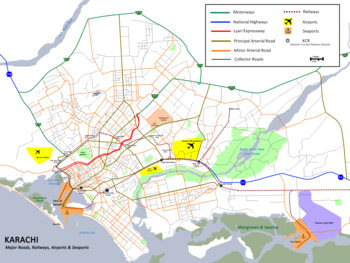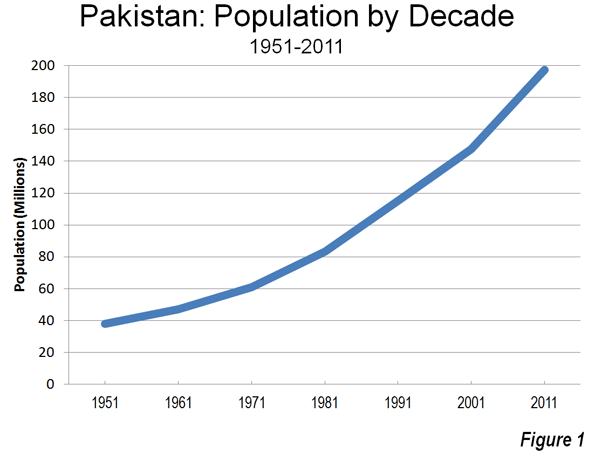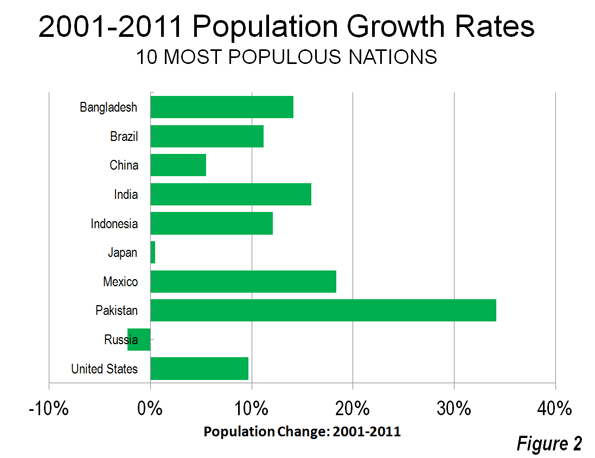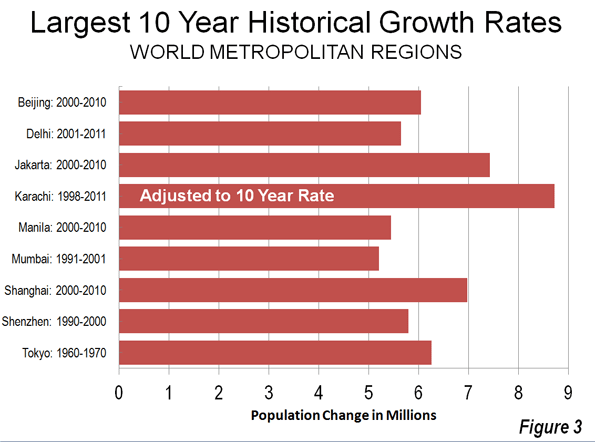
In much the developed, as well as developing world, population growth is slowing. Not so in Pakistan according to reported preliminary results of the 2011 Pakistan census. Here population is growing much faster than had been projected. Pakistan's population stood at 197.4 million in 2011, an increase of 62.7 million from the last census in 1998 (Note 1). The new population is 20 million more than had been forecast in United Nations documents. Some of the additional growth is due to refugees fleeing Afghanistan, but this would not be enough to account for the majority of the under-projection error.
Pakistan: Moving Up the League Tables
As a result, Pakistan has passed Brazil and become the world's 5th most populous nation, following China, India, the United States and Indonesia. Pakistan's 11 year growth rate is estimated at 34.2 percent, nearly double that of second ranking Mexico, at 18.2 percent, where the birth rate (as indicated by the total fertility rate) is projected to drop to under replacement rate by the end of the decade. Perhaps most significantly, Pakistan's growth rate is more than double the rates of India (15.9 percent) and Bangladesh (14.1 percent),which have long had reputations for strong growth (Table and Figure 1). At this growth rate, Pakistan could become the world's fourth most populous nation by 2030, passing Indonesia.
| Table | |||||
| 10 Most Populous Nations: 2000-2011: Population Trends | |||||
| Rank | Nation | 2000 | 2011 | Change | % Change |
| 1 | China | 1,278.0 | 1,348.0 | 70.0 | 5.5% |
| 2 | India | 1,071.0 | 1,241.0 | 170.0 | 15.9% |
| 3 | United States | 285.5 | 313.1 | 27.6 | 9.7% |
| 4 | Indonesia | 216.2 | 242.3 | 26.1 | 12.1% |
| 5 | Pakistan | 147.1 | 197.4 | 50.2 | 34.2% |
| 6 | Brazil | 176.9 | 196.7 | 19.8 | 11.2% |
| 7 | Bangladesh | 131.9 | 150.5 | 18.6 | 14.1% |
| 8 | Russia | 146.1 | 142.8 | (3.3) | -2.3% |
| 9 | Japan | 125.9 | 126.5 | 0.6 | 0.5% |
| 10 | Mexico | 97.0 | 114.8 | 17.8 | 18.4% |
| Population in Millions | |||||
| Population data from UN, except for Pakistan (from Pakistan census) | |||||
| 2000 Pakistan population estimated from 1998-2011 growth rate. | |||||

Remarkably, while much of the world has seen a reduction in fertility rates and population growth, Pakistan's growth rate has increased. Between 1991 and 2001, Pakistan grew 25 percent, a rate that increased by more than one third (to 34 percent) between 2001 and 2011 (Figure 2). Pakistan's total fertility rate (TFR --- the number of live births the average woman has in her lifetime) is reported by the UN to be 3.2. This is well above India's rate of 2.6 and far above the Bangladesh rate of 2.2 (which is only barely above the generally accepted replacement rate of 2.1). Pakistan's fertility rate is the highest of any of the largest countries and one of the highest in the world outside sub-Saharan Africa.

Not surprisingly, the average household size is very high, at 6.8. This is a slight decline from the rate of 6.9 in 1998. By comparison, more developed countries, such as in Europe and North America, tend to have average household sizes of from 2.2 to 2.6.
Karachi: World's Leading Urban Area by 2030?
Pakistan's largest metropolitan region and capital of Sindh province, Karachi, grew even faster. Between 1998 to 2011, Karachi grew from 9.8 million to 21.2 million, adding more than 11 million people (115 percent). No metropolitan region in the world has ever grown so much in so little a period. This 13 year growth rate, adjusted to 10 years, is 8.7 million. Until the last decade, only Tokyo, among the larger world metropolitan regions, had ever grown more than 6 million in 10 years (6.2 million from 1960 to 1970). Between 2000 and 2010, Jakarta grew 7.4 million, Shanghai grew 7.0 million and Beijing added 6.0 million people. (See Figure 3.)

Mexico City and Sao Paulo, with their reputations for explosive growth rates, are now expanding at only 3 million (or less) per decade, and their growth is slowing. The fastest growing metropolitan regions in regions in Europe and North America peaked at similar numbers. New York's greatest growth was 3.4 million between 1920 and 1930, while Los Angeles grew 3.1 million from 1980 to 1990.
The early census results indicate an urban area (area of continuous urban development, a part of a metropolitan area) population of approximately 19.5 million, which would rank Karachi as the 7th largest in the world. With an urban land area of approximately 310 square miles (800 square kilometers), Karachi has an average population density of approximately 63,000 per square mile (24,000 per square kilometer), making it more dense than any "megacity" (urban area over 10 million population) except for Dhaka (Bangladesh) at 115,000 per square mile (44,000 per square kilometer) and Mumbai (80,000 per square kilometer and 31,000 per square mile)
Karachi's strong growth now places it among a group of large and rapidly growing urban areas that could challenge Tokyo to become the world's largest urban area in 20 years. Indeed, should Karachi's now 6.0 percent growth rate fall to 4.0 percent, Karachi would still be the world's largest urban area in 2030, followed by Jakarta, given its present growth rate. With Tokyo likely to begin losing population by that time, Delhi may pass Tokyo by 2030 as well.
At the same time, Karachi is densifying in an unusual way: it is increasing its average household size. While the average household size is dropping modestly in the nation as a whole, Karachi's average household size rose from 6.7 to 7.3 between 1998 and 2011, meaning that nearly 10 percent of any recent density increase is within housing units (it is not known whether this is due to higher local fertility rates or "doubling up" of family units in housing units).
As the largest metropolitan area of one of the world's largest nations, Karachi draws residents from the rest of the nation (and outside) to take advantage of its economic opportunities. Pakistan is not a rich country, with a gross domestic product (purchasing power parity) of less than $3,000 per capita in 2011. This compares generally to rates of $30,000 to $40,000 in the larger European Union economies, $40,000 to $50,000 in Australia, Canada, United States and Hong Kong and $60,000 in Singapore. However, incomes are higher in Karachi than in the rest of the country.
As huge numbers of people have migrated to Karachi, many have been forced to live in informal settlements (slums), as squatters. In 2000, it was estimated that approximately 5 million of Karachi's residents (nearly 50 percent) at the time lived in slums.
Hyderabad
Hyderabad (Pakistan, not India) is the second largest metropolitan region in the province of Sindh. Hyderabad's claim to fame is that it is growing even faster than Karachi. Between 1998 and 2011, Hyderabad grew from 1.4 million to 3.4 million, or 129 percent.
Other Areas
So far, the reported census results are limited to the provincial data and local data in the province of Sindh. However, in view of the strong growth rates around the nation, it seems likely that the count in the nation's second largest urban area, Lahore, will surpass 10 million.
Urban Growth in Pakistan
Finally, any review of suburban and exurban land use on Google Earth suggests that Pakistan is taking the advice of the United Nations in its State of the World Population Report 2007: Unleashing the Potential of Urban Growth, which said (Note 2):
(a) expanding their city limits; (b) planning for road grids in the areas of expansion; (c) locating
the required 25- to 30-metre-wide right-of-way for the infrastructure grid on the ground
Radiating both from Karachi and Hyderabad, there are new grids of streets for housing and other development of a type that will allow the burgeoning cities of Pakistan to grow and perhaps even breathe at the same time.
Wendell Cox is a Visiting Professor, Conservatoire National des Arts et Metiers, Paris and the author of “War on the Dream: How Anti-Sprawl Policy Threatens the Quality of Life.”
------------------
Photo: Map of Karachi by Wikipedia user Nomi887
Note 1: This population includes the areas of Kashmir administered by Pakistan (and claimed by India) and excludes the areas of Kashmir administered by India (and claimed by Pakistan).
Note 2: This concept was pioneered by Professor Schlomo (Solly) Angel of New York University and Princeton University, who proposed that developing world urban areas provide grids of dirt roads to accommodate their rapidly growing populations. This would ensure a better planned urban area and lead to more healthful living conditions (and avoid the necessity of high-density slums or shantytowns).












